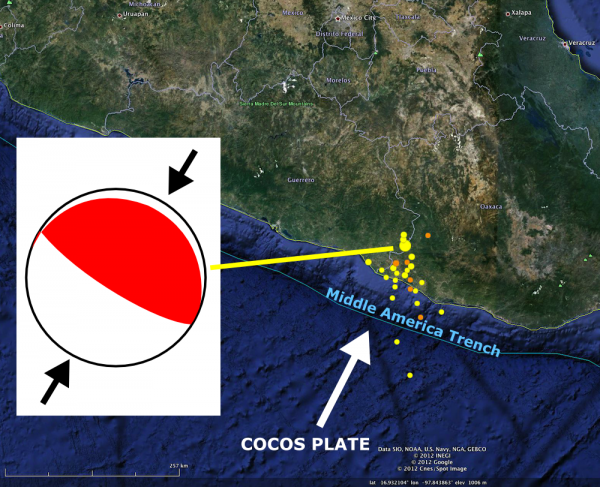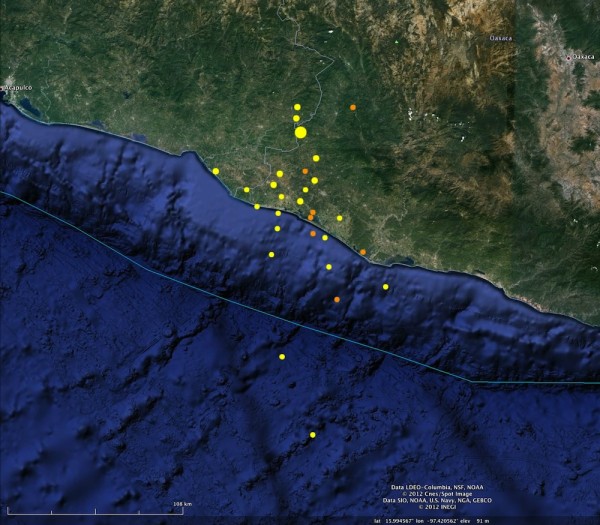 The largest earthquake to hit the planet this week was in Mexico, which was shaken on Tuesday by a magnitude 7.4 earthquake. The epicentre was in the Oaxaca region about 300 kilometres southwest of Mexico city, and the rupture was quite shallow at about 20 kilometres below the surface. The focal mechanism indicates that the earthquake was due to northeast-southwest thrusting (see my primer on focal mechanisms).
The largest earthquake to hit the planet this week was in Mexico, which was shaken on Tuesday by a magnitude 7.4 earthquake. The epicentre was in the Oaxaca region about 300 kilometres southwest of Mexico city, and the rupture was quite shallow at about 20 kilometres below the surface. The focal mechanism indicates that the earthquake was due to northeast-southwest thrusting (see my primer on focal mechanisms).

Location and focal mechanism of the 20th March M7.4 earthquake near Oaxaca, Mexico. Imagery from Google Earth, earthquake locations from the USGS.
The rupture was about 100 km inland from Middle America Trench, where the Cocos plate is being subducted to the northeast beneath Mexico, and is at the right depth to be on the subduction thrust. Interestingly, it also seems to be at about the distance from the trench 
Close up of region around the epicentre of the Oaxaca earthquake, showing the distribution of aftershocks (biggest circle is the main shock). Imagery from Google Earth, earthquake locations from the USGS.
One of the reasons that I was thinking about this is that although this earthquake was quite large, and caused a fair amount of damage close to the epicentre, Mexico as a whole seems to have got off quite lightly. This contrasts with the 1985 magnitude 8.0 earthquake that killed 10,000 people and caused severe damage to buildings in Mexico City (which is built on unconsolidated sediments that can amplify the shaking caused by the passage of seismic waves). The epicentre of that earthquake was up the coast to the northwest, in a similar location relative to the Middle America Trench as this week’s tremor, and a similar distance from Mexico City. So why the large difference in their impacts? The 1985 event was stronger: a magnitude 8 releases about 8 times as much energy as a magnitude 7.4, which is probably a major factor in the reduced casualties and damage. Also, one of the legacies of the 1985 disaster has been more rigorous building codes and efforts to increase earthquake preparedness; it is a more resilient Mexico than it was 25 years ago. But if much of the seismic energy from this earthquake was directed away from Mexico City, as the aftershocks might indicate, then this might have helped to reduce the regional impacts as well.
![]() The largest earthquake to hit the planet this week was in Mexico, which was shaken on Tuesday by a magnitude 7.4 earthquake. The epicentre was in the Oaxaca region about 300 kilometres southwest of Mexico city, and the rupture was quite shallow at about 20 kilometres below the surface. The focal mechanism indicates that the earthquake was due to northeast-southwest thrusting (see my primer on focal mechanisms).
The largest earthquake to hit the planet this week was in Mexico, which was shaken on Tuesday by a magnitude 7.4 earthquake. The epicentre was in the Oaxaca region about 300 kilometres southwest of Mexico city, and the rupture was quite shallow at about 20 kilometres below the surface. The focal mechanism indicates that the earthquake was due to northeast-southwest thrusting (see my primer on focal mechanisms).




Comments (1)
Links (1)-
Pingback: Stuff we linked to on Twitter last week | Highly Allochthonous